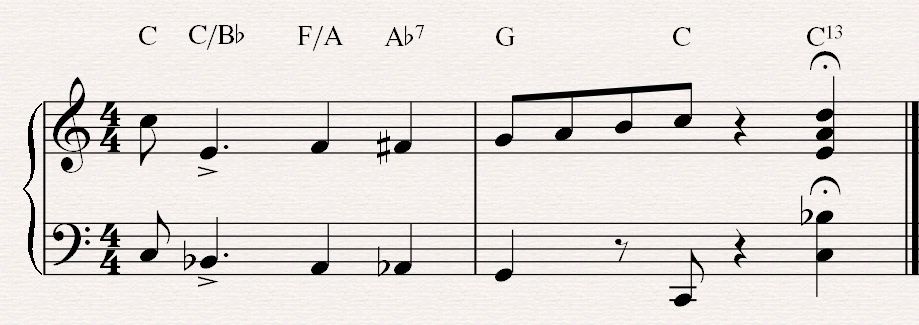Last semester, I was in a "Jazz Improv" course, which taught improvisation through the study of standard melodic devices, idiomatic scales, and listening/transcription projects. For one transcription assignment, I chose an Oscar Peterson solo on the song
"Night and Day." I chose O.P. because I love how he develops ideas and structures solos, all with with his signature touch and impeccable sense of time.
A word on transcription
Transcription can be useful for finding lines that you like and integrating them into your own vocabulary, verbatim. But what I like to do, rather than memorize and regurgitate a line exactly, is to identify lines that sound good to me, and then really dissect them and try to figure out
why they sound good. (Maybe it's the rhythm that I like, or maybe it's the contour of the melodic line, or maybe it's the use of space, etc.)
And after listening to plenty of solos from my favorite players, over time, I start to see the 'common denominators' —what sorts of musical qualities tend to resonate with me?
From there, I can work on integrating those qualities (not necessarily the exact line verbatim) into my playing. That way, my style is influenced and informed by my musical role models, but my playing is still unique and 'my own.'
The lick
So let's get back to Oscar Peterson and look at just a couple measures from the "Night and Day" solo (click to enlarge):
 |
| Original O.P. lick, with target notes in blue. |
After spending some time analyzing the line, I took an inventory of the passage's most obvious characteristics:
- Static harmony (it all occurs over one chord, Ebmaj7)
- Rhythmic repetition (two eighth notes, four sixteenth notes)
- Contour of line: large leaps up, sprinkled with small movements down (like taking three steps up a staircase, one step down, three more steps up, another down, etc.)
- Enclosure
Enclosure and embellishment
Let's focus in on the last bullet point: enclosure. To do so, I'm going to sort of reverse-engineer the line so that we can understand exactly how the enclosure is working. This process is essentially a Schenkerian method of analysis. (Heinrich Schenker said that a piece of music can be reduced down to its most basic elements, and from this structural base, a composer 'composes out' (
Auskomponierung) by way of elaboration and embellishment.)
First, we can reduce the whole line into four structural half notes (highlighted in blue, Fig. 1).
 |
| Figure 1: Structural 'target' notes. |
From there, you can think of the other notes as embellishments of these primary notes, achieved by way of approaching the target note. A common way to approach (precede) a note is through enclosure: playing the notes just above and below the target note.
I have notated this concept in Fig. 2, with slightly condensed rhythmic activity (flattening the first measure into all eighth notes). It works by using two "above" notes and one "below" note to connect beat 1 with the target note on beat 3.
This idea from beats 1-2 is sequenced (repeated up a fourth) on beats 3-4, and it is this repetition that gives the line a sense of structure. The second measure introduces a new connective idea, an ascending Eb major 7 arpeggio up to the F.
 |
| Figure 2: Simplified line, with 3-note approaches to target notes (labelled in bar 1). |
To get from Fig. 2 (condensed version) to O.P.'s actual line, we add a little bit more embellishment to beats 2 and 4 of the first measure. This is done by adding 'upper neighboring tones,' achieved by increasing the rhythmic activity from eighth notes to sixteenths. (For example, on beat 2, we change Db - B [eighths] to Db - D - Db - B [sixteenths]. The 'D' in this case would be the upper neighbor).
And...
voila! We arrive at the original lick (finally!).
The takeaway
Of course all of this analysis is rather long-winded and perhaps reeks of academic stuffiness. Surely, while playing his solo, Oscar Peterson wasn't consciously thinking, "Okay, that was a structural note... now let's connect it to beat 3 with a three-note enclosure. Oh, that sounded nice; let me do that again, this time up a fourth..." (Well, maybe he was...)
The point of this all, then, is to identify and analyze techniques and devices, and 'shed' them in the practice room. Work on them to the point that you no longer need to think through all those theoretical steps. In other words, master the technique; internalize it.
For instance, from these couple measures, I would hone in on the idea of
enclosure, and I'd try to figure out how to apply it to my own playing. (I might start by looking at a standard jazz head and identifying a melody note as my target note. Then, I could practice enclosing that target note.)
This is just one way to begin applying a new concept. The point is to think of creative ways to apply new ideas, and to practice the techniques until a level of familiarity/comfort is reached.
Once you really
own an idea, it's yours, and you will then gain insight into how you might apply the idea in other contexts, and how you might adapt the idea to meet new musical challenges. (And that's a lot of
fun.)




